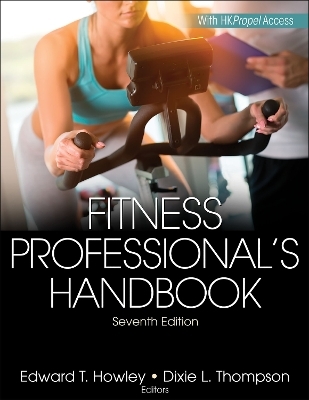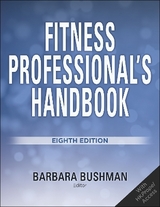
Fitness Professional's Handbook
Human Kinetics (Verlag)
978-1-4925-2337-6 (ISBN)
This full-color text incorporates information from the 10th edition of ACSM’s Guidelines for Exercise Testing and Prescription and the Physical Activity Guidelines for Americans exercise and physical activity recommendations for adults, older adults, children, and those with special needs. The text embraces the importance of communication between allied health and medical professionals with those in the fitness arena to provide readers with a foundation for prescribing exercise and delivering need- and goal-specific physical activity and fitness programs.
Every chapter has been updated, allowing readers to explore the newest theories and research findings and apply them to real-world situations. The following are among the most significant changes to the seventh edition:
• Related online content delivered via HKPropel that includes an online video library containing 24 video clips to help readers better apply key techniques covered in the book, as well as fillable forms that students can use beyond the classroom
• A new chapter, “Training for Performance,” helps professionals expand their practice to work with recreational athletes who have performance-related goals
• New information, including the consequences of exercise-induced muscle damage (rhabdomyolysis), devices used to track physical activity and estimate energy expenditure (e.g., accelerometers), relative flexibility and the role of lumbopelvic rhythm in back function, the importance of progression in an exercise prescription, and the professional standard of care associated with HIIT programs reflects recent topics of interest and research
• Updated statistics on CVD and CHD from the American Heart Association, adult and childhood obesity, and the prevalence of COPD, asthma, bronchitis, and emphysema ensure accurate representation of data
• Chapter quizzes have been added to an updated ancillary package that also includes an instructor guide, test package, presentation package, and image bank
With a comprehensive and practical approach, this text enables readers to help individuals, communities, and groups gain the benefits of regular physical activity in a positive and safe environment. It provides background to the field, scientific fundamentals, and up-to-date recommendations to help readers better understand the role of physical activity in the quality of life and guidelines for screening, testing, supervising, and modifying activity for various populations.
Note: A code for accessing HKPropel is included with all new print books.
Edward T. Howley, PhD, FACSM, FNAK, earned his bachelor’s degree from Manhattan College and his master’s and doctorate degrees from the University of Wisconsin at Madison. He then completed a one-year postdoctoral appointment at Penn State University and was hired in 1970 as a faculty member at the University of Tennessee at Knoxville. Howley taught a variety of courses, including an undergraduate course in fitness testing and prescription and undergraduate and graduate courses in exercise physiology. He retired in 2007 and holds the rank of professor emeritus. In addition to the previous editions of this book, Dr. Howley has authored three books, four book chapters, and more than 60 research articles dealing with exercise physiology, fitness testing, and prescription. He is a fellow in the National Academy of Kinesiology and served as chair of the Science Board of the President’s Council on Physical Fitness and Sports in 2006-2007. In 2007-08 he served on the Physical Activity Guidelines Advisory Committee that evaluated the science related to physical activity and health and generated a report for use by the U.S. Department of Health and Human Services to write the 2008 Physical Activity Guidelines for Americans. Most of Dr. Howley’s volunteer efforts have been with the American College of Sports Medicine (ACSM). He was involved in the development of certification programs and served as president in 2002-03. He served as editor in chief of ACSM’s Health & Fitness Journal for seven years and as chair of the program planning committee for the annual ACSM Health and Fitness Summit meeting. In 2007, Howley was recognized for his professional contributions with the ACSM Citation Award. In his leisure time, he likes to golf, ride his bike, travel, and play with his grandchildren. Dixie L. Thompson, PhD, FACSM, FNAK, is vice provost and dean of the graduate school at the University of Tennessee at Knoxville and is a professor in the department of kinesiology, recreation, and sports studies. She graduated from the 2008 class of the Higher Education Resource Services (HERS) Bryn Mawr Summer Institute, held at Bryn Mawr College. The Summer Institute is a professional development program dedicated to the advancement of female leaders in administration of higher education. She also participated in the 2009-2010 Academic Leadership Development Program sponsored by the Southeastern Conference Academic Consortium. Dr. Thompson focuses her research on the health benefits of exercise for women and techniques used for body composition assessment. She is the author of over 70 peer-reviewed publications and numerous articles for fitness professionals and general audiences. She is a former associate editor in chief for ACSM's Health & Fitness Journal and former editor in chief for ACSM's Fit Society Page Newsletter. Dr. Thompson is a fellow of the American College of Sports Medicine (ACSM) and a member of the ACSM Board of Trustees. She is a fellow of the National Academy of Kinesiology. She is a past president of the Southeast Chapter of ACSM and former chair of the Physical Fitness Council for the American Alliance for Health, Physical Education, Recreation and Dance. Dr. Thompson received her BA in physical education and MA in exercise physiology from the University of North Carolina at Chapel Hill. She eaarned her PhD from the University of Virginia.
Part I. Physical Activity: Links to Health, Fitness, and Performance
Chapter 1. Health, Fitness, and Performance
Edward T. Howley
Chapter 2. Health Risk Appraisal
Michael Shipe
Part II. Scientific Foundations
Chapter 3. Functional Anatomy and Biomechanics
Clare E. Milner
Chapter 4. Exercise Physiology
Edward T. Howley
Chapter 5. Nutrition
Dixie L. Thompson
Chapter 6. Measurements of Energy Cost in Physical Activity
Edward T. Howley
Part III. Fitness Assessment
Chapter 7. Assessment of Cardiorespiratory Fitness
Edward T. Howley
Chapter 8. Assessment of Body Composition
Dixie L. Thompson
Chapter 9. Assessment of Muscular Fitness
Avery Faigenbaum
Chapter 10. Assessment of Flexibility and Low-Back Function
Laura Horvath Gagnon
Part IV. Exercise Prescription for Health, Fitness, and Performance
Chapter 11. Exercise Prescription for Cardiorespiratory Fitness
Edward T. Howley
Chapter 12. Exercise Prescription for Weight Management
Dixie L. Thompson
Chapter 13. Exercise Prescription for Muscular Fitness
Avery Faigenbaum
Chapter 14. Exercise Prescription for Flexibility and Low-Back Function
Laura Horvath Gagnon
Chapter 15. Training for Performance
Scott A. Conger
Part V. Special Populations
Chapter 16. Exercise for Children and Youth
Edward T. Howley
Chapter 17. Exercise and Older Adults
Edward T. Howley
Chapter 18. Exercise and Women’s Health
Dixie L. Thompson
Chapter 19. Exercise and Heart Disease
David R. Bassett, Jr.
Chapter 20. Exercise and Obesity
Dixie L. Thompson
Chapter 21. Exercise and Diabetes
Dixie L. Thompson
Chapter 22. Exercise and Pulmonary Disease
David R. Bassett, Jr.
Part VI. Comprehensive Exercise Program Considerations
Chapter 23. Behavior Change
Janet Buckworth
Chapter 24. ECG and Exercise Performance
David R. Bassett, Jr.
Chapter 25. Injury Prevention and Treatment
Jenny Moshak
Chapter 26. Legal Considerations
JoAnn M. Eickhoff-Shemek
| Erscheinungsdatum | 03.12.2016 |
|---|---|
| Verlagsort | Champaign, IL |
| Sprache | englisch |
| Maße | 216 x 279 mm |
| Gewicht | 1950 g |
| Themenwelt | Sachbuch/Ratgeber ► Gesundheit / Leben / Psychologie |
| Sachbuch/Ratgeber ► Sport ► Fitness / Aerobic / Bodybuilding | |
| ISBN-10 | 1-4925-2337-2 / 1492523372 |
| ISBN-13 | 978-1-4925-2337-6 / 9781492523376 |
| Zustand | Neuware |
| Haben Sie eine Frage zum Produkt? |
aus dem Bereich



